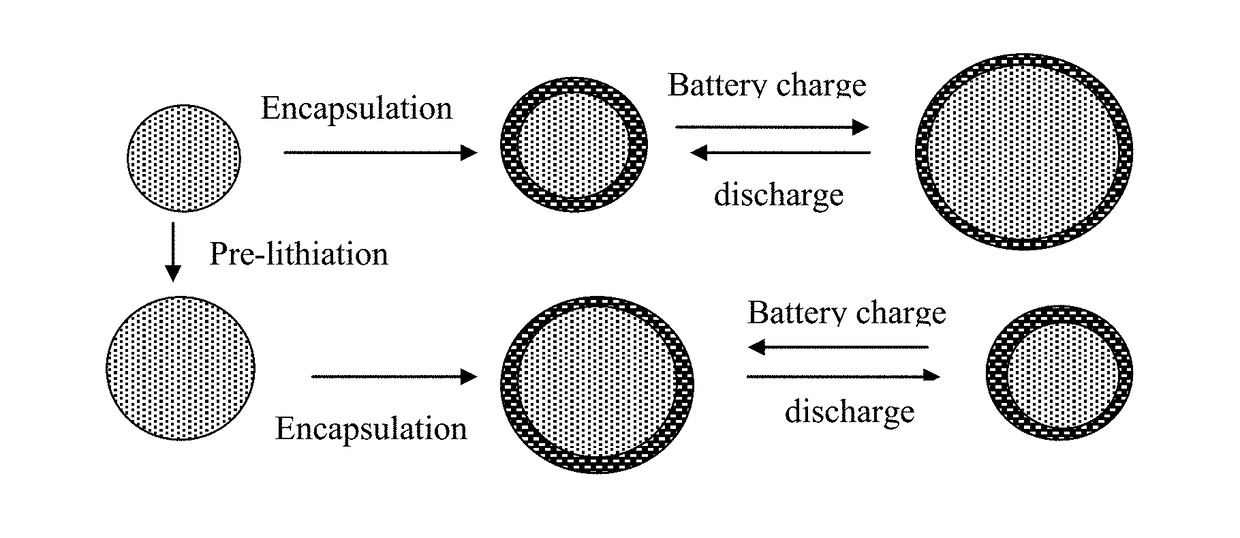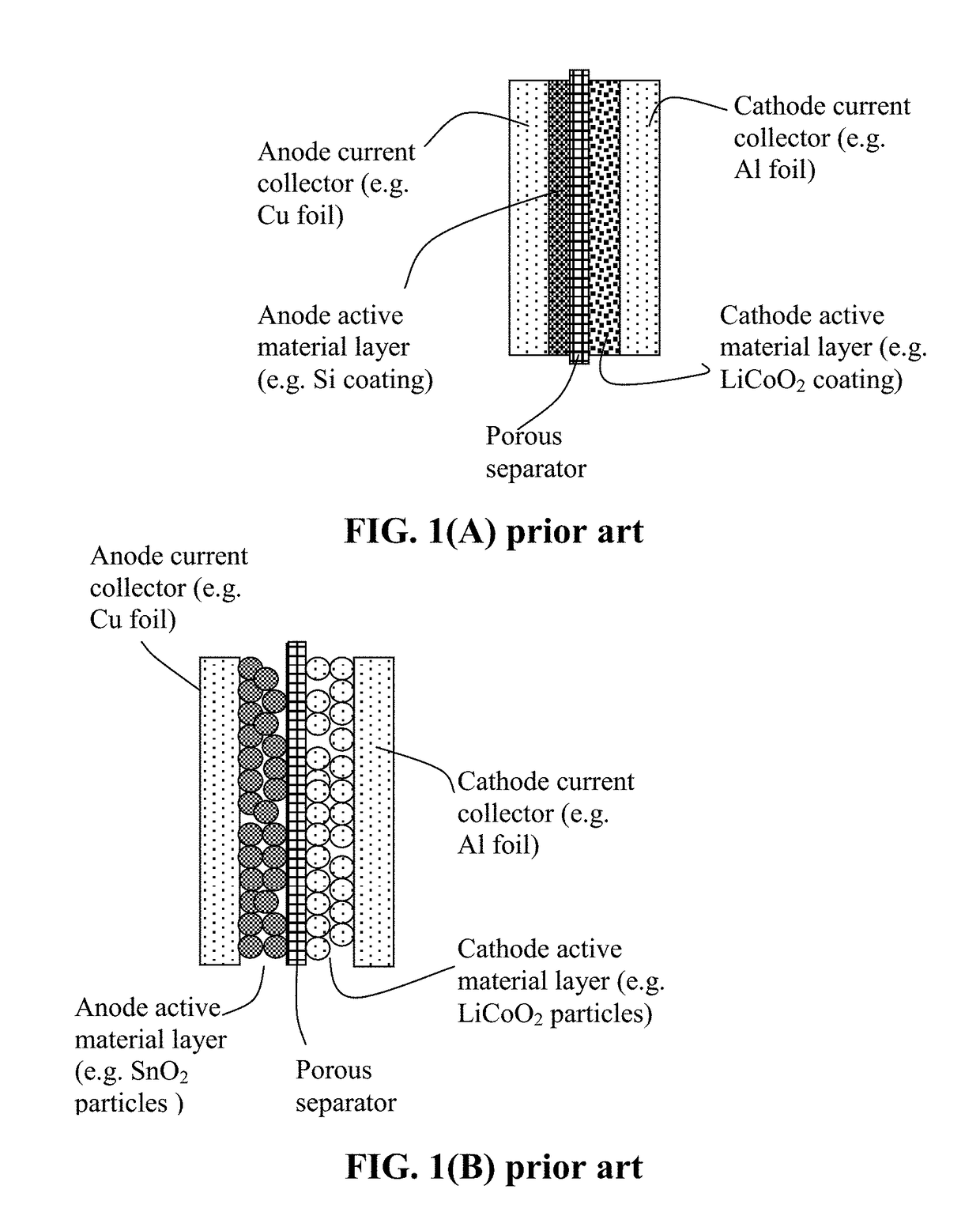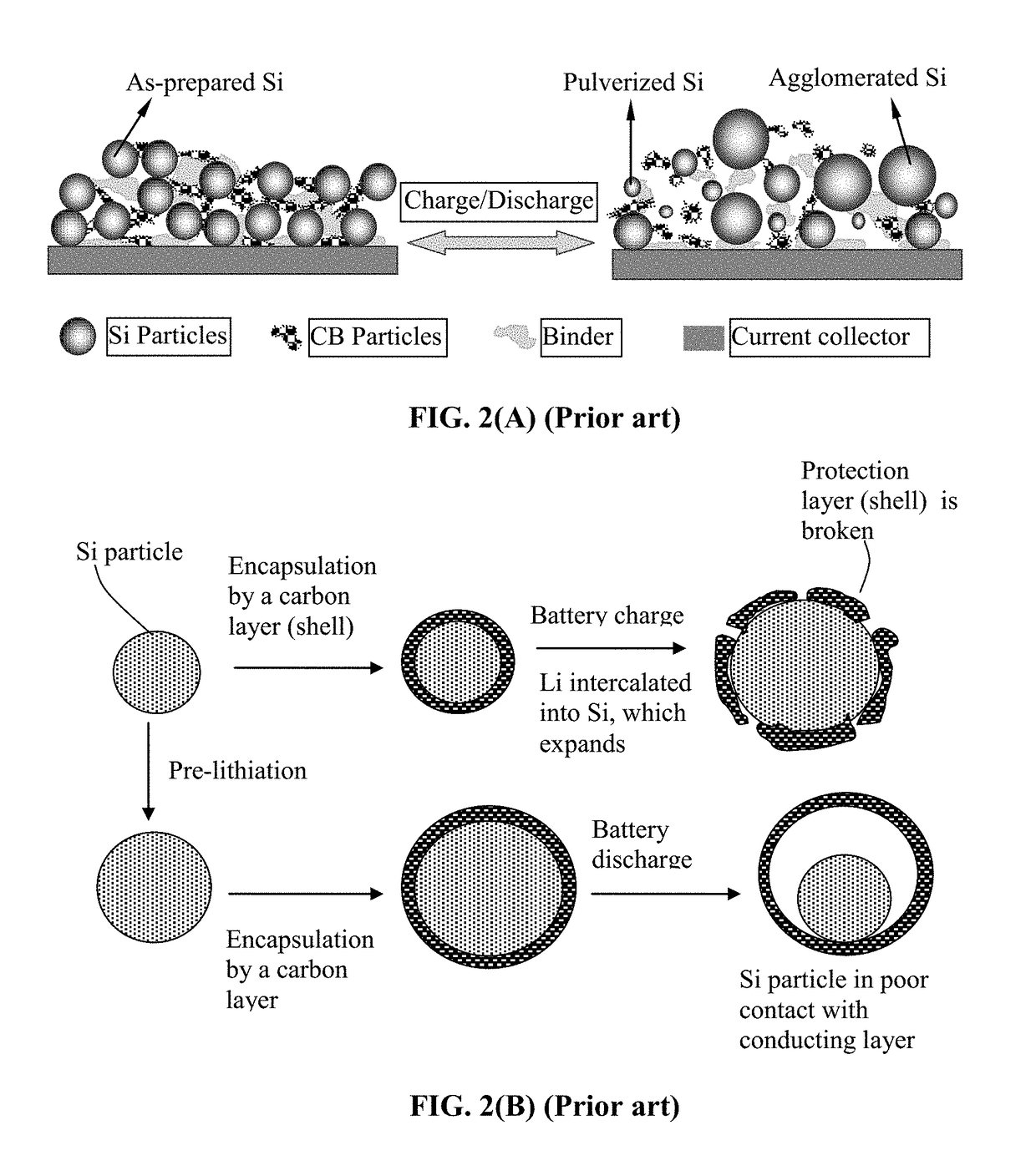Method of Manufacturing a Lithium Secondary Battery Having a Protected High-Capacity Anode Active Material
a lithium secondary battery and high-capacity technology, applied in the field of rechargeable lithium batteries, can solve the problems of severe pulverization (fragmentation of alloy particles), loss of contacts between active material particles and conductive additives, etc., to achieve the effect of improving lithium ion conductivity to a polymer
- Summary
- Abstract
- Description
- Claims
- Application Information
AI Technical Summary
Benefits of technology
Problems solved by technology
Method used
Image
Examples
example 2
-Encapsulated Tin Oxide Particulates
[0100]Tin oxide (SnO2) nano particles were obtained by the controlled hydrolysis of SnCl4.5H2O with NaOH using the following procedure: SnCl4.5H2O (0.95 g, 2.7 m-mol) and NaOH (0.212 g, 5.3 m-mol) were dissolved in 50 mL of distilled water each. The NaOH solution was added drop-wise under vigorous stirring to the tin chloride solution at a rate of 1 mL / min. This solution was homogenized by sonication for 5 m in. Subsequently, the resulting hydrosol was reacted with H2SO4. To this mixed solution, few drops of 0.1 M of H2SO4 were added to flocculate the product. The precipitated solid was collected by centrifugation, washed with water and ethanol, and dried in vacuum. The dried product was heat-treated at 400° C. for 2 h under Ar atmosphere. A dilute elastomer-solvent solution (0.01-0.1 M of cis-polyisoprene in cyclohexane and 1,4-dioxane) was used as a coating solution in an air-suspension method to produce elastomer-encapsulated SnO2 particles hav...
example 3
Nano Particles Encapsulated by a Styrene-Butadiene Rubber (SBR)
[0102]Nano particles (76 nm in diameter) of Sn were encapsulated with a thin layer of SBR shell via the spray-drying method, followed by curing of the butadiene segment of the SBR chains to impart high elasticity to the SBR. For comparison, some amount of Sn nano particles was encapsulated by a carbon shell. Carbon encapsulation is well-known in the art. Un-protected Sn nano particles from the same batch were also investigated to determine and compare the cycling behaviors of the lithium-ion batteries containing these particles as the anode active material.
[0103]Shown in FIG. 7 are the discharge capacity curves of three coin cells having three different Sn particles as the anode active material: elastomer-encapsulated Sn particles, carbon-encapsulated Sn particles, and un-protected Sn particles. These results have clearly demonstrated that elastomer encapsulation strategy provides the very best protection against capacit...
example 4
re-Based Particulates
[0104]In a typical procedure, approximately 2.112 g of silicon powders (average diameter 2.64 μm) were mixed with 80 ml of a 0.1M aqueous solution of Ni(NO3).6H2O and vigorously stirred for 30 min. Then, water was evaporated in a rotary evaporator and the solid remnants were completely dried in an oven at 150° C. The final sample (Ni-impregnated Si powers) was obtained by grinding the solids in a mortar.
[0105]Subsequently, 0.03 g of Ni-impregnated Si particles was placed in a quartz boat, and the boat was placed in a tube furnace. The sample was reduced at 500° C. for 4 hours under flowing Ar (180 sccm) and H2 (20 sccm), then the temperature was raised to 990° C. to catalytically synthesize Si nanowires; Si nanowires were found to emanate from original micron-scaled Si particles. For the purpose of separating Si nanowires, for instance, every 0.1 g of the reacted Si powders was mixed with 10 ml of ethanol and the resulting mixture was sonicated for 1 hour. Subse...
PUM
| Property | Measurement | Unit |
|---|---|---|
| thickness | aaaaa | aaaaa |
| lithium ion conductivity | aaaaa | aaaaa |
| diameter | aaaaa | aaaaa |
Abstract
Description
Claims
Application Information
 Login to View More
Login to View More - R&D
- Intellectual Property
- Life Sciences
- Materials
- Tech Scout
- Unparalleled Data Quality
- Higher Quality Content
- 60% Fewer Hallucinations
Browse by: Latest US Patents, China's latest patents, Technical Efficacy Thesaurus, Application Domain, Technology Topic, Popular Technical Reports.
© 2025 PatSnap. All rights reserved.Legal|Privacy policy|Modern Slavery Act Transparency Statement|Sitemap|About US| Contact US: help@patsnap.com



